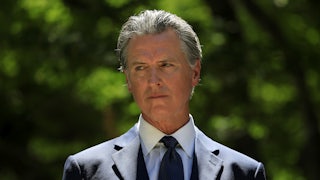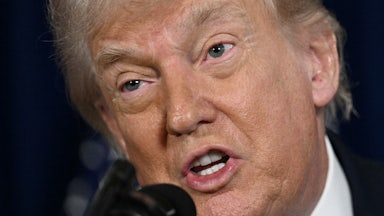If there’s any comparison Kyrsten Sinema wants made about herself, it’s to John McCain. The first-term Arizona senator calls McCain a “personal hero” and said that the late senator “taught us to always assume the best in others, to seek compromise instead of sowing division, and to always put country ahead of party.” She’s also been known to tell her staffers, “I want to be the next John McCain.”
She’s even mimicked McCain’s gestures at pivotal voting moments. Sinema gave a thumbs-down on a proposal for raising the minimum wage, aping McCain’s famous gesture when the GOP got as close as it ever could to gutting Obamacare fully. McCain got plenty of blowback for that vote. Sinema is getting a similar level of criticism for slowing down and cutting back President Biden’s set of domestic policy proposals.
But alumni of John McCain’s campaigns and Senate office—the people who worked the closest with him in politics—don’t see Sinema’s recent moves as a carbon copy of what the late senator would do. One glaring difference, they say, is that McCain’s threshold for taking a deal was much clearer. “When McCain was in the middle of something like this, he wanted to make the deal,” Mark Salter, one of McCain’s closest advisers and aides, said over email.
Interviews with more than half a dozen former McCain aides and staffers reveal a mixed view of Sinema’s actions. They understand and even respect Sinema’s refusal to toe the party line on a major bill and her eagerness to praise a legendary member of the opposing party. But these aides also caution that McCain was always clearer about his objections and support.
McCain “was clear-eyed legislatively and knew what he wanted to accomplish,” Becki Donatelli, who served as chief internet consultant for McCain, said in an email. “And so did everybody else LOL. He didn’t play coy that’s for sure.”
Sinema’s shifting and conflicting political views have left Democrats frustrated and confused, and worse. On top of that, her refusal to explain her objections or priorities publicly has left most of the political world wondering and speculating about what Sinema’s actual motivations are. There have even been rumors that she could switch parties, an outlandish possibility that McCain toyed with for a hot second, according to former Senator Tom Daschle.
But the similarities only go so far, cautioned former McCain spokesman Tim Miller.
“McCain certainly had a contrarian streak, and I think they have that in common. But McCain also had principles that he was adhering to—most of the time—and he told you exactly what he thought,” Miller said. “When he bucked the party on campaign finance or immigration, it was because of his underlying philosophy. What exactly is Sinema’s objection to the Democrats’ agenda? Is it based in some underlying principle or policy objection? Nobody really knows. She’s inscrutable. That’s very un-McCainlike (if that’s a word).”
The way McCain and Sinema have defied the majority of their party is also very different. Presidential candidates often offer up examples of crossing party lines and agreeing with the opposing team on something. For McCain, that was his work with then-Senator Russ Feingold on a far-reaching campaign finance reform proposal in the early 2000s. He worked with Democrats on legislation for reforming prescription drug sales, and on a patients’ bill of rights. He also voted against George W. Bush’s tax cuts—an apostasy for today’s tax-hating Republican Party. He also pushed legislation creating a dramatic price increase on tobacco products, as well as new strong restrictions for the tobacco industry. In all these cases, McCain went against his own party’s leaders (Mitch McConnell hates campaign finance reform more than anything), special interests, and big donors.
And yet McCain was no RINO, and his choices had serious implications. There’s a direct line between McCain’s rash and terrible decision to pick Sarah Palin as his running mate in the 2008 presidential election and the rise of Donald Trump (Palin bucked backing Ted Cruz, helping to elevate Trump to lead the Republican Party). And for all his defiant moments, he was in lockstep with conservatives on issues ranging from abortion to same-sex marriage to financial deregulation. McCain was an outspoken supporter of invading Iraq and Afghanistan, as well, something Democrats relentlessly hit him on when he ran for president in 2008. It was clear where McCain was, and was not, a maverick.
Sinema’s political beliefs always seem
to be in flux. She was once a member of the Green Party but has since
become more conservative as she’s risen through the ranks of American politics
and elected office. The negotiations have not been an instructive window into
Sinema’s core beliefs. She’s reportedly prioritizing
environmental provisions but is eager to cut the overall price tag
of the reconciliation package dramatically. She’s opposed to raising corporate taxes to pay for the Biden domestic policy agenda. She opposed
some of the most expansive (and popular) measures on prescription drug pricing
in the set of proposals, as well. And back in the Trump era, she was one of the few
Democratic senators who voted
to confirm Bill Barr as Trump’s attorney general.
Sinema’s core beliefs remain a mystery to almost everyone. She rarely talks to any member of the press and refuses hallway interviews or gaggles. That may seem like a small thing, but it’s important to consider in any comparison to McCain, Mr. Straight Talk Express, who would literally outlast most barrages of reporters’ questions. It was clear where McCain stood on specific issues because he would tell you and anyone else.
Still, alums of McCain World agree that Sinema’s opposition to major Democratic proposals will help her in Arizona. “Whether she is following the lead of Senator McCain or not, it is encouraging to see politicians who look first at what they think is best for the country before considering what is best for their party or their political interests,” said Christian Ferry, a former deputy campaign manager to McCain.
Mike DuHaime, a former political director for McCain’s presidential campaign, said it’s smart for Sinema to liken herself to the Republican senator. “I take it as a great compliment to his legacy of political courage and independence,” DuHaime said. “Americans are craving leaders who don’t simply toe the party line every time, so in this instance, the comparison makes sense. I am sure the most partisan Democrats don’t like the comparison, but it will help her in Arizona, especially among more centrist voters.”
McCain’s independent streak engendered a distinct following among Republicans. He was the maverick who wanted to fight corporate largesse and moneyed interests in Washington, D.C. He also allied himself with some of the most ardent Republican spending hawks in the chamber.
Sinema’s Democratic alliances are increasingly few and far between. Democratic outside groups have begun airing ads attacking Sinema as too close to major lobbying organizations and interest groups—the same groups McCain loved to troll. If there’s a substantive difference between McCain and Sinema, it’s that: McCain occasionally took on corporate and big-money power in the name of promoting the broader public interest. Sinema, right now, is doing something that looks like the opposite of that.






